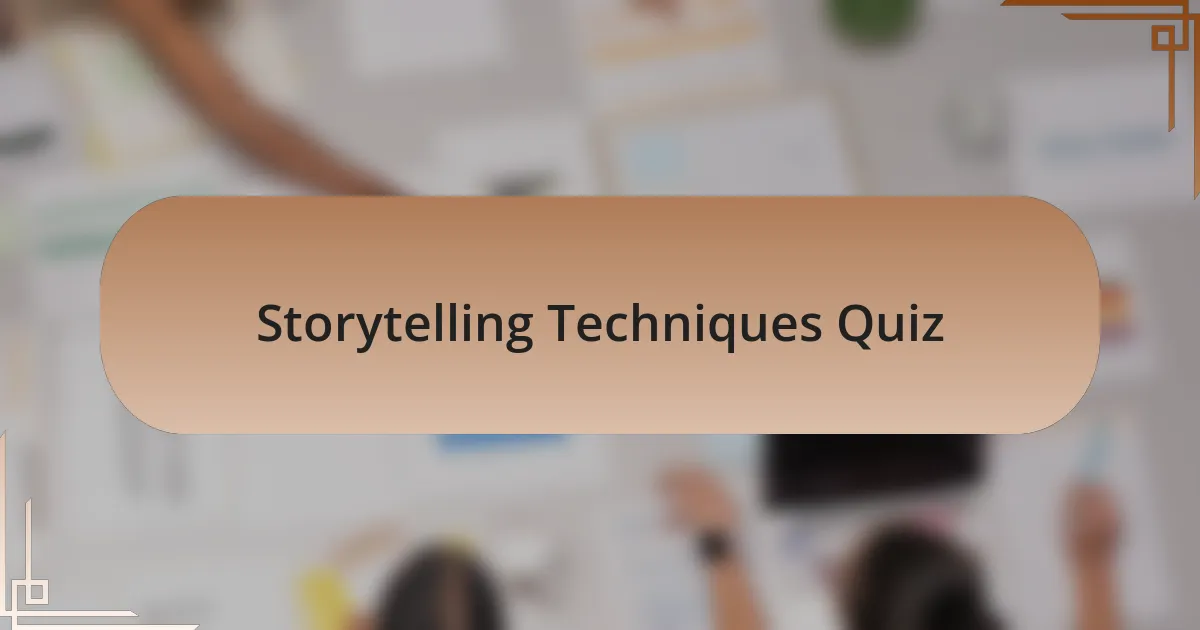Start of Storytelling Techniques Quiz
1. What is the role of humor in the `Monomyth` storytelling technique?
- Humor only exists in comedies and has no place in the `Monomyth` technique.
- Humor provides comic relief and enhances character development in the `Monomyth` storytelling technique.
- Humor distracts from the plot and confuses the audience in the `Monomyth` technique.
- Humor serves no purpose and is unused in the `Monomyth` storytelling technique.
2. How can the `Mountain` storytelling technique incorporate comedic elements?
- By limiting character dialogue to convey tension.
- By strictly adhering to a chronological sequence of events.
- By introducing absurd scenarios that escalate dramatically.
- By making the hero face serious, life-threatening situations.
3. What humorous effects can be achieved using `Nested Loops`?
- Nested Loops always result in a straightforward plotline.
- Nested Loops can create humor through unexpected narrative twists.
- Nested Loops can only tell a singular story effectively.
- Nested Loops eliminate any form of character development.
4. How do `Sparklines` create comedic contrast in stories?
- Sparklines focus solely on character development humor.
- Sparklines use jokes to lighten serious moments.
- Sparklines contrast the ordinary with the ideal for humor.
- Sparklines are only meant for dramatic storytelling.
5. What funny scenarios arise from the `In Medias Res` technique?
- A character decides to bake a cake and ends up creating a volcano.
- A character goes fishing and catches an ancient sword made of cheese.
- A character takes a nap and wakes up in a video game world.
- A character shows up at a party in a superhero costume, interrupting a boring gathering.
6. How can `Converging Ideas` be used to tell a humorous story?
- By avoiding any punchlines or surprises.
- By blending humor from different perspectives.
- By using only one joke throughout the story.
- By presenting a single character`s viewpoint only.
7. What comedic surprises can a `False Start` introduce in storytelling?
- A predictable conclusion
- A longer exposition
- A simple character introduction
- Unexpected twists in the narrative
8. In what ways can the `Petal Structure` enhance comedic narratives?
- The Petal Structure enhances comedic narratives by strictly adhering to a single format, preventing any creative experimentation in humor.
- The Petal Structure enhances comedic narratives by organizing humor around a central theme, allowing multiple jokes to bloom effectively.
- The Petal Structure enhances comedic narratives by eliminating all humor for a serious tone, making it more impactful.
- The Petal Structure enhances comedic narratives by focusing solely on one character`s journey, ignoring others to simplify the story.
9. How does `Setting` set up humor in storytelling?
- Setting only establishes character names.
- Setting is solely about plot twists.
- Setting describes the dialogue between characters.
- Setting influences the mood and tone of a story.
10. How can `Foreshadowing` be used humorously in narratives?
- By placing characters in completely unrelated scenarios.
- By avoiding any hints about future events entirely.
- By setting up humorous stakes that later lead to a funny resolution.
- By making all characters serious without any jokes.
11. What comedic implications does a `Cliffhanger` have in storytelling?
- A Cliffhanger distracts from the main plot by introducing irrelevant characters.
- A Cliffhanger wraps up the story neatly and concludes all plot lines.
- A Cliffhanger keeps viewers engaged by leaving the story unresolved.
- A Cliffhanger provides a detailed explanation of every character`s fate.
12. How can `Flashbacks` be used for comedic relief in a narrative?
- Flashbacks are used to slow down the story and make it dull.
- Flashbacks can reveal embarrassing past moments that provide humor.
- Flashbacks only provide serious plot details without any humor.
- Flashbacks show future events that add tension and no laughter.
13. What humorous outcomes can a `Red Herring` lead to in storytelling?
- Excessive narration makes the story highly predictable.
- Misleading clues keep the audience guessing.
- Confusing timelines create boredom and detachment.
- Characters make silly puns throughout the plot.
14. How can an `Epiphany` create a comic twist in a story?
- It reveals a hidden joke or absurdity in a serious situation.
- It turns dramatic moments into slapstick comedy.
- It forces characters to battle with water balloons.
- It makes every character break into spontaneous song.
15. What humorous advantages does a `First-Person Narrator` offer?
- Eliminates the need for character development
- Adds humor through personal anecdotes
- Enhances action with more fight scenes
- Forces readers to guess the plot twist
16. How can `Multiperspectivity` provide diverse comedic viewpoints?
- Multiperspectivity focuses only on comedic timing without character viewpoints.
- Multiperspectivity shows different character viewpoints by using multiple narrators and perspectives.
- Multiperspectivity eliminates all character perspectives for a straightforward narrative.
- Multiperspectivity relies on a single narrator to share the whole story.
17. What role does a `Metaphor` play in humorous storytelling?
- Serves as a distraction from the story
- Creates confusion in the plot
- Limits creativity and originality
- Enhances comedic effect through exaggeration
18. How does `In Medias Res` start a story on a comedic note?
- It begins with an extensive character introduction with no action.
- It opens with a philosophical monologue about life.
- It starts with a long, detailed backstory to set the scene.
- It begins with a hilarious mishap that immediately engages the audience.
19. What comedic elements are present in the `Hero`s Journey`?
- Epic battles
- Serious reflections
- Tragic monologues
- Comic relief during trials
20. How does `Show, Don`t Tell` enhance comedic storytelling?
- It focuses solely on character backstory.
- It encourages lengthy dialogues for laughter.
- It consists of telling jokes at the end.
- It uses visual elements to illustrate humor.
21. What pacing techniques help in building comedic tension?
- Ignoring audience reactions
- Using complicated vocabulary
- Focusing solely on moral lessons
- Timing pauses effectively
22. Why is `Clarity` particularly important in humorous storytelling?
- It can confuse the audience for added humor.
- It ensures every joke is presented in a different language.
- It helps the audience follow the punchlines clearly.
- It makes the story longer and more complex.
23. How does `Knowing Your Audience` enhance the humor in storytelling?
- Making jokes that only the storyteller finds funny is the best approach.
- Ignoring audience preferences makes humor more enjoyable for everyone.
- Tailoring content to audience preferences enhances relatability and humor.
- Using complex language ensures that all audiences understand the humor.
24. What is the purpose of a humorous `Hook` in narratives?
- To make the narrative longer
- To confuse the reader
- To provide detailed backstory
- To capture the audience`s attention
25. How can `Being Clear and Concise` contribute to effective humor?
- It delivers punchlines effectively.
- It makes jokes confusing.
- It overwhelms the audience with details.
- It avoids the use of humor.
26. In what way does `Getting Personal` amplify comedic connectivity?
- It focuses solely on slapstick humor.
- It avoids any emotional connection with the audience.
- It allows comedians to relate their personal experiences.
- It emphasizes complex philosophical jokes.
27. How does `Body Language` convey humor in storytelling?
- Body Language only describes the plot of the story.
- Body Language has no impact on audience engagement.
- Body Language focuses purely on dialogue exchange.
- Body Language enhances comedic timing through gestures and expressions.
28. Why is `Practicing Often` essential for honing comedic storytelling?
- It guarantees laughter every time.
- It helps refine their technique.
- It makes them tell jokes.
- It ensures they avoid failure.
29. What benefits arise from asking for feedback on comedic narratives?
- It guarantees instant laughter from all audiences.
- It makes the comedian look more impressive.
- It helps refine the narrative for better audience engagement.
- It allows the comedian to joke about any topic freely.
30. How does `Using a Hook` specifically keep the humor alive in storytelling?
- By keeping all jokes to a minimum for clarity.
- By eliminating any distractions in the narrative.
- By creating suspense about the plot`s direction.
- By ensuring every character is serious and straightforward.
Congratulations on Completing the Quiz!
Well done on finishing the quiz about storytelling techniques! We hope you had a blast while flexing your creative muscles. Storytelling is more than just a tradition; it’s a powerful tool. You likely learned how humor can enhance a narrative, draw in your audience, and create memorable moments. It’s not just about what you say, but how you say it. And let’s face it—every great tale needs a sprinkle of laughter!
Through the quiz, you’ve explored techniques such as timing, punchlines, and the art of exaggeration. Each of these plays a crucial role in crafting engaging stories. Humor can break the ice and make your narrative relatable. Funny anecdotes can turn ordinary situations into exceptional tales. Now that’s something to chuckle about!
If you enjoyed this quiz, you’re in for a treat! Head over to the next section on this page to dive deeper into storytelling techniques. There, you’ll find insights that can enhance your skills even further. Expand your knowledge and keep the laughter rolling in your stories. Happy storytelling!
Storytelling Techniques
Understanding the Basics of Humor in Storytelling
Humor in storytelling is the technique of eliciting laughter through narrative elements. It involves the use of wit, puns, irony, and absurdity to engage the audience. Effective humor often relies on timing and the unexpected. Jokes or humorous situations can break tension or create connection. This approach makes stories memorable and enhances audience enjoyment.
Types of Humor Techniques in Storytelling
There are several types of humor techniques used in storytelling, including slapstick, wordplay, and satire. Slapstick relies on physical comedy, like exaggerated movements or accidents. Wordplay often involves puns and clever language twists. Satire critiques social norms through exaggeration or irony. Each technique serves to add layers of meaning and engages diverse audience responses.
Character-Driven Humor in Narratives
Character-driven humor emerges from the personalities, quirks, and interactions of characters. This technique enhances relatability, as unique character traits can lead to comedic situations. For example, an overly serious character placed in absurd scenarios highlights their contrasting nature, leading to humor. This fosters a deeper connection between characters and the audience.
The Role of Timing and Pacing in Comedic Storytelling
Timing and pacing are crucial for effective humor in storytelling. Proper timing determines when a punchline lands, influencing audience reaction. Slow pacing can build anticipation, enhancing the eventual payoff of humor. Conversely, rapid-fire jokes can create a comedic rhythm. Mastering these elements allows storytellers to maximize comedic effect and maintain audience engagement.
Incorporating Cultural References in Humor
Cultural references in humor enrich storytelling by connecting to shared experiences or knowledge. This technique can evoke laughter by evoking familiar concepts or events. However, it’s essential to consider the audience’s background and context. Successful cultural humor resonates with the audience, often leading to a deeper understanding and appreciation of the narrative.
What are effective storytelling techniques in humor?
Effective storytelling techniques in humor include timing, exaggeration, and set-ups with punchlines. Timing is crucial; delivering a joke at just the right moment enhances its impact. Exaggeration amplifies the absurdity of a situation, making it funnier. Set-ups prepare the audience for the punchline, which provides the unexpected twist that evokes laughter. Studies show that jokes structured this way are more likely to elicit positive emotional responses, as they align well with cognitive processing theories in humor.
How can one improve their humor storytelling skills?
One can improve humor storytelling skills through practice, observing humorists, and analyzing joke structures. Regularly telling stories and seeking feedback can enhance delivery and timing. Observing comedians helps identify effective patterns and techniques. Analyzing the structure of successful jokes reveals common elements that lead to laughter, such as misdirection and clever wordplay. Research indicates that identifying these techniques significantly boosts the ability to craft humorous narratives.
Where can humor storytelling be effectively utilized?
Humor storytelling can be effectively utilized in various settings, including public speaking, presentations, and social media. In public speaking, humor engages the audience, making the message more memorable. In presentations, it can lighten complex topics, aiding comprehension. Social media thrives on humor; it captures attention and encourages sharing. According to statistics, posts with humorous content receive higher engagement rates, illustrating its effectiveness in communication.
When is humor most effective in storytelling?
Humor is most effective in storytelling during moments of tension or when introducing relatable experiences. In narratives, strategic humorous relief during tense situations can enhance enjoyment and alleviate discomfort. Additionally, humor is particularly effective when the audience can relate to the scenario, as shared experiences foster connection. Research in psychology shows that relatable humor increases audience engagement and improves retention of the story’s message.
Who are notable figures known for their humor storytelling?
Notable figures known for their humor storytelling include comedians like Robin Williams, Jerry Seinfeld, and Tina Fey. Robin Williams was renowned for his rapid-fire wit and improvisational skills. Jerry Seinfeld’s observational humor often drew from everyday life, making it universally relatable. Tina Fey excelled in blending humor with sharp commentary in her storytelling. These comedians have won multiple awards, demonstrating their impact and influence in the field of humor storytelling.


